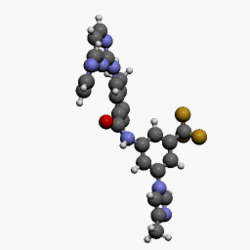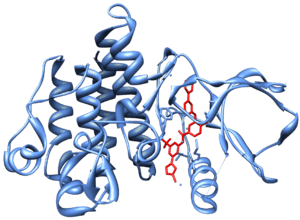Nilotinib
 | |
 | |
| Clinical data | |
|---|---|
| Trade names | Tasigna |
| AHFS/Drugs.com | Monograph |
| MedlinePlus | a608002 |
| License data | |
| Pregnancy category | |
| Routes of administration | Oral |
| ATC code | L01XE08 (WHO) |
| Legal status | |
| Legal status | |
| Pharmacokinetic data | |
| Bioavailability | 30%[1] |
| Protein binding | 98%[1] |
| Metabolism | Hepatic (mostly CYP3A4-mediated)[1] |
| Biological half-life | 15-17 hours[1] |
| Excretion | Faeces (93%)[1] |
| Identifiers | |
| |
| CAS Number |
641571-10-0(base) |
| PubChem (CID) | 644241 |
| IUPHAR/BPS | 5697 |
| DrugBank |
DB04868 |
| ChemSpider |
559260 |
| UNII |
F41401512X |
| KEGG |
D08953 |
| ChEBI |
CHEBI:52172 |
| ChEMBL |
CHEMBL255863 |
| PDB ligand ID | NIL (PDBe, RCSB PDB) |
| ECHA InfoCard | 100.166.395 |
| Chemical and physical data | |
| Formula | C28H22F3N7O |
| Molar mass | 529.5245 g/mol |
| 3D model (Jmol) | Interactive image |
| |
| |
| | |
Nilotinib (AMN107, trade name Tasigna[2]), in the form of the hydrochloride monohydrate salt, is a small-molecule tyrosine kinase inhibitor approved for the treatment of imatinib-resistant chronic myelogenous leukemia.[3] Structurally related to imatinib,[4] it was developed based on the structure of the Abl-imatinib complex to address imatinib intolerance and resistance.[5][6][7] Nilotinib is a selective Bcr-Abl kinase inhibitor[5][6] that is 10-30 fold more potent than imatinib in inhibiting Bcr-Abl tyrosine kinase activity and proliferation of Bcr-Abl expressing cells.[4][6][7][8]
Medical uses

It is FDA- (29 October 2007),[9] EMA- (29 September 2009),[10] MHRA- (19 November 2007)[11] and TGA- (17 January 2008)[12] approved for use as a treatment for Philadelphia chromosome (Ph+)-positive chronic myelogenous leukaemia.[1]
The drug carries a black box warning for possible heart complications.[13][14]
Clinical trials
CML
In June 2006, a phase I clinical trial found nilotinib has a relatively favorable safety profile and shows activity in cases of CML resistant to treatment with imatinib, another tyrosine kinase inhibitor currently used as a first-line treatment.[15] In that study 92% of patients (already resistant or unresponsive to imatinib) achieved normal white blood cell counts after five months of treatment.[16]
Other
Novartis announced on April 11, 2011 that it is discontinuing a phase III trial of Tasigna (nilotinib) for investigational use in the first-line treatment of gastrointestinal stromal tumor (GIST) based on the recommendation of an independent data monitoring committee. Interim results showed Tasigna is unlikely to demonstrate superiority compared to Novartis's Glivec (imatinib)*, the current standard of care in this setting.[17]
Nilotinib is currently being trialed in people with Parkinson's disease as it appears to be able to halt progression of the disease and even improve their symptoms . The researchers behind the trial think that the drug blocks a protein that interferes with the action of lysosomes which normally destroy harmful proteins in the brain.[18]
The use of low doses of nilotinib is being investigated for use for Parkinson's, and Alzheimer's disease, as well as for ALS, dementia and Huntington's disease.[19]
Contraindications
Contraindications include long QT syndrome, hypokalaemia, hypomagnesaemia, pregnancy, planned pregnancy, lactation and galactose/lactose intolerance.[1][12]
Cautions include:[1]
- Myelosuppression
- Tumour lysis syndrome
- Liver impairment
- History of pancreatitis
- Check serum lipase periodically in order to detect pancreatitis
- Total gastrectomy
- Avoid pregnancy or impregnating women
Dose reduction of nilotinib has been recommended in hepatically impaired population which involves recommendation of lower starting dose and monitoring of any hepatic function abnormalities.[20]
Adverse effects
Nilotinib has a number of adverse effects typical of anti-cancer drugs. These include headache, fatigue, gastrointestinal problems such as nausea, vomiting, diarrhea and constipation, muscle and joint pain, rash and other skin conditions, flu-like symptoms, and reduced blood cell count. Less typical side effects are those of the cardiovascular system, such as hypertension (high blood pressure), various types of arrhythmia, and prolonged QT interval. Nilotinib can also affect the body's electrolyte and glucose balance.[9] Though pulmonary-related adverse effects are rare when compared with imatinib and dasatinib, there is a case report of acute respiratory failure from diffuse alveolar hemorrhage in a patient taking nilotinib.[21]
Interactions
Nilotinib has been reported as a substrate for OATP1B1 and OATP1B3. Interaction of nilotinib with OATP1B1 and OATP1B3 may alter its hepatic disposition and can lead to transporter mediated drug-drug interactions.[20] Nilotinib is an inhibitor of OATP-1B1 transporter but not for OATP-1B3.[22]
It is a substrate for CYP3A4 and hence grapefruit juice and other CYP3A4 inducers will increase its action and inhibitors like St. John's wort will decrease it. Strong pharmaceutical CYP3A4 inducers can triple its action.[1] Patients report that pomegranates and starfruit may also interfere.
Food should not be eaten two hours before or one hour afterwards because it unpredictably increases its bioavailability, approximately doubling it.
Pharmacology
Nilotinib inhibits the kinases BCR-ABL,[23] KIT, LCK, EPHA3, EPHA8, DDR1, DDR2, PDGFRB, MAPK11 and ZAK.[24]
See also
- Bcr-Abl tyrosine-kinase inhibitor#Nilotinib (AMN107) re development and resistance
References
- 1 2 3 4 5 6 7 8 9 "Tasigna (nilotinib) dosing, indications, interactions, adverse effects, and more". Medscape Reference. WebMD. Retrieved 25 January 2014.
- ↑ Official Manufacturer Website http://www.tasigna.com
- ↑ "Cancer Drug Information: Nilotinib".
- 1 2 Manley, P.; Cowan-Jacob, S.; Mestan, J. (2005). "Advances in the structural biology, design and clinical development of Bcr-Abl kinase inhibitors for the treatment of chronic myeloid leukaemia". Biochimica et Biophysica Acta. 1754 (1–2): 3–13. doi:10.1016/j.bbapap.2005.07.040. PMID 16172030.
- 1 2 Manley, P.; Stiefl, N.; Cowan-Jacob, S.; Kaufman, S.; Mestan, J.; Wartmann, M.; Wiesmann, M.; Woodman, R.; Gallagher, N. (2010). "Structural resemblances and comparisons of the relative pharmacological properties of imatinib and nilotinib". Bioorganic & Medicinal Chemistry. 18 (19): 6977–6986. doi:10.1016/j.bmc.2010.08.026. PMID 20817538.
- 1 2 3 Jabbour, E., Cortes, J., Kantarjian, H. (2009). "Nilotinib for the treatment of chronic myeloid leukemia: An evidence-based review". Core evidence 4: 207-213.
- 1 2 Olivieri, A.; Manzione, L. (2007). "Dasatinib: a new step in molecular target therapy". Annals of Oncology. 18 Suppl 6: vi42–vi46. doi:10.1093/annonc/mdm223. PMID 17591830.
- ↑ Breccia, M.; Alimena, G. (2010). "Nilotinib: a second-generation tyrosine kinase inhibitor for chronic myeloid leukemia". Leukemia research. 34 (2): 129–134. doi:10.1016/j.leukres.2009.08.031. PMID 19783301.
- 1 2 "Complete Nilotinib information from Drugs.com". Drugs.com. Retrieved 25 January 2014.
- ↑ "Tasigna : EPAR - Product Information" (PDF). European Medicines Agency. Novartis Europharm Ltd. 18 October 2013. Retrieved 25 January 2014.
- ↑ "Tasigna 150mg Hard Capsules - Summary of Product Characteristics (SPC)". electronic Medicines Compendium. Novartis Pharmaceuticals UK Ltd. 9 September 2013. Retrieved 25 January 2014.
- 1 2 "TASIGNA® nilotinib" (PDF). TGA eBusiness Services. 21 October 2013. Retrieved 25 January 2014.
- ↑ "FDA Approves Tasigna for Treatment of Philadelphia Chromosome Positive Chronic Myeloid Leukemia". U.S. Food and Drug Administration. 2007-10-30. Retrieved 2009-08-04.
- ↑ "Prescribing information for Tasigna (nilotinib) Capsules" (PDF). NDA 022068. U.S. FDA. 2007-10-29. Retrieved 2009-08-04.
- ↑ Kantarjian H; Giles, Francis; Wunderle, Lydia; Bhalla, Kapil; O'Brien, Susan; Wassmann, Barbara; Tanaka, Chiaki; Manley, Paul; Rae, Patricia; Mietlowski, William; Bochinski, Kathy; Hochhaus, Andreas; Griffin, James D.; Hoelzer, Dieter; Albitar, Maher; Dugan, Margaret; Cortes, Jorge; Alland, Leila; Ottmann, Oliver G.; et al. (2006). "Nilotinib in imatinib-resistant CML and Philadelphia chromosome-positive ALL". N Engl J Med. 354 (24): 2542–51. doi:10.1056/NEJMoa055104. PMID 16775235.
- ↑ "Patients with treatment-resistant leukemia achieve high responses to Tasigna (nilotinib) in first published clinical trial results". MediaReleases. Novartis. 2006-06-14. Retrieved 2009-08-04.
- ↑ http://www.novartis.com/newsroom/media-releases/en/2011/1504991.shtml
- ↑
- ↑ http://medicalxpress.com/news/2013-05-cancer-drug-build-up-toxic-brain.html
- 1 2 Khurana V, Minocha M, Pal D, Mitra AK (March 2014). "Role of OATP-1B1 and/or OATP-1B3 in hepatic disposition of tyrosine kinase inhibitors.". Drug Metabol Drug Interact. 0 (0): 1–11. doi:10.1515/dmdi-2013-0062. PMID 24643910.
- ↑ Donatelli, Christopher, Daych Chongnarungsin, and Rendell Ashton. "Acute respiratory failure from nilotinib-associated diffuse alveolar hemorrhage." Leukemia & Lymphoma 0 (2014): 1-6.
- ↑ Khurana V, Minocha M, Pal D, Mitra AK (May 2014). "Inhibition of OATP-1B1 and OATP-1B3 by tyrosine kinase inhibitors.". Drug Metabol Drug Interact. 0 (0): 1–11. doi:10.1515/dmdi-2014-0014. PMID 24807167.
- ↑ Weisberg E, Manley P, Mestan J, Cowan-Jacob S, Ray A, Griffin JD (June 2006). "AMN107 (nilotinib): a novel and selective inhibitor of BCR-ABL". Br. J. Cancer. 94 (12): 1765–9. doi:10.1038/sj.bjc.6603170. PMC 2361347
 . PMID 16721371.
. PMID 16721371. - ↑ Manley, PW; Drueckes, P; Fendrich, G; Furet, P; Liebetanz, J; Martiny-Baron, G; Mestan, J; Trappe, J; et al. (2010). "Extended kinase profile and properties of the protein kinase inhibitor nilotinib". Biochimica et Biophysica Acta. 1804 (3): 445–53. doi:10.1016/j.bbapap.2009.11.008. PMID 19922818.
External links
- Discovery and development of Bcr-Abl tyrosine kinase inhibitors
- New drug information/Abbreviated Scientific Narrative
- Highlights of Prescription information Nilotinib (August 2007) Novartis Pharmaceuticals Corporation (USA)
- Summary of Product Characteristics Nilotinib (November 2007) Novartis AG (Europe)